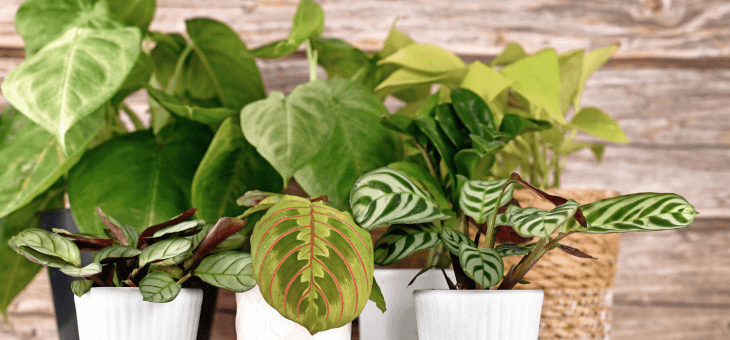Houseplants certainly brighten up a room but some have much more interesting features than just being nice to look at.
Some move at night, emit scent when you brush your hands over them and even snap shut if prey lands on their leaves.
1. Prayer plant (Maranta leuconeura)
The prayer plant, so called because it raises its leaves in the evening as though it is praying, is a great one to watch.
“Every night, the leaves roll up and you can hear them moving as well,” says gardener Claire Bishop.
“They are great plants for kids, as they’re not toxic. And the fact you can see the plant alive and moving gets kids interested,” she explains. “It’s one of the easiest plants to look after, but it actually looks stunning. It can double in size in a couple of months.”
Marantas prefer plenty of light, but not direct sunlight, along with well-drained soil and high humidity.
Read: Six plants that thrive indoors
2. Calathea
Closely related to the maranta, these increasingly popular exotic-looking plants, are also known as peacock plants, and are similar to the prayer plant in that most of them move.
Flowers are not a feature of these plants but their leaves are show stoppers.
Calathea leaves are paddle-shaped, some have impressive toothed or wavy margins giving a flattering effect. These leaves come in a range of colours and patterns combining contrasting light and dark markings. Some Calathea even have bright pink or red markings.
“There’s a particular type called the rattlesnake plant, whose leaves open and close every day, because their leaves need the sunlight. They will open up every day and then close back up again to conserve energy when it gets darker,” Ms Bishop says.
Rattlesnake plants need bright indirect light. Water them when the top 4.5cm of soil has dried out and avoid getting the leaves wet. Don’t use shine products on dusty leaves. Just wipe them occasionally with a damp cloth.
3. Venus flytrap
Afternoon sun on the VFT.#venusflytrap #carnivorousplant #sundayvibes pic.twitter.com/da5wKjgPTz
— Brian Romero (@brianromero) January 30, 2022
The Venus flytrap is one of nature’s cleverest plants. Most have evolved to survive in situations where the soil holds little or no nutrition, so the plant makes its own food by catching and decomposing small insects. The Venus flytrap is perhaps one of the most fascinating of the carnivorous plants, and it’s surprisingly easy to grow.
This plant is popular in homes, its leaves snapping shut when an unsuspecting insect climbs in to investigate and is promptly trapped in its vice-like grip and later digested. It’s fussy about its food, preferring spiders, ants, beetles and grasshoppers, with a few flying insects thrown in.
The trap is an ingenious mechanism. Tiny hairs trigger the trap to close when an insect brushes against them, trapping the insect inside. The insect is then dissolved by digestive juices emitted by the trap, reducing it to liquid fertiliser.
To trigger the trap, two hairs need to be touched within 20 seconds of each other. Then, when the trap closes, the hairs need to be triggered five more times for the digestive cycle to start.
They need direct sunlight to remain healthy, otherwise their leaves will become weak and floppy. Plant them in a sandy, damp soil and water them with rain water, preferably sitting them in about 1cm of water, rather than watering them from the top.
4. Alocasia
Increasingly popular among houseplant fans, because of their unusual shaped leaves and distinctive veins, these beauties spring visibly back to life after a good water.
Indoors, Alocasia need moderately bright light, but avoid direct sunlight on their leaves in summer, as this can cause foliage burn. Keep the large leaves clean of dust by wiping them with a damp cloth from time to time. This will keep them healthy and looking attractive.
“There are a lot of really unusual ones out there. There’s a beautiful one called ‘Pink Dragon’ with pink stems and unusual leaves,” Ms Bishop recommends.
Read: How houseplants can make you feel like you’re on holiday
5. Philodendron
Bold and absolutely beautiful, philodendron is a must-have for your home. There are many varieties to choose from, all with interesting forms, different sizes and growth habits. The one thing they have in common is lush, glossy green leaves. Plant enough of them and they’ll turn any room into a mini tropical paradise.
You may not see them move before your eyes, but play around with a time-lapse camera and you should enjoy the vast movement of the leathery leaves overnight.
6. Peperomia Clusiifolia ‘Red Margin’
For those who prefer scent, this moderately drought-tolerant candidate has leaves that smell like sweet pepper. It prefers to be kept on the dry side, especially in lower light conditions; so let the top of the soil dry out by about four centimetres before each watering.
They are said to be an excellent air purifying plant.
Read: ‘Super plants’ could help reduce air pollution in your home and garden
7. Monstera
Known as the Swiss cheese plant, this striking houseplant should make significant growth if you put it in moderate brightness but out of direct sunlight. Winter brightness is essential, otherwise you’ll get spindly stalks and leggy growth.
8. Oxalis triangularis
This plant is particularly active because of its striking reactions to light changes. As it moves in response to light intensity, its look changes dramatically. Film them with a time-lapse camera, and you’ll see how much they move towards the sunlight over a 24-hour period.
Oxalis will grow best with lots of bright, indirect light. To prevent your oxalis from getting overly leggy and leaning to one side – rotate the pot a 1/4 turn once a week or so.
Do you have a favourite house plant? Why is it your favourite? Why not share your opinion in the comments section below?
Also read: Surprising uses of milk in your garden
– With PA

